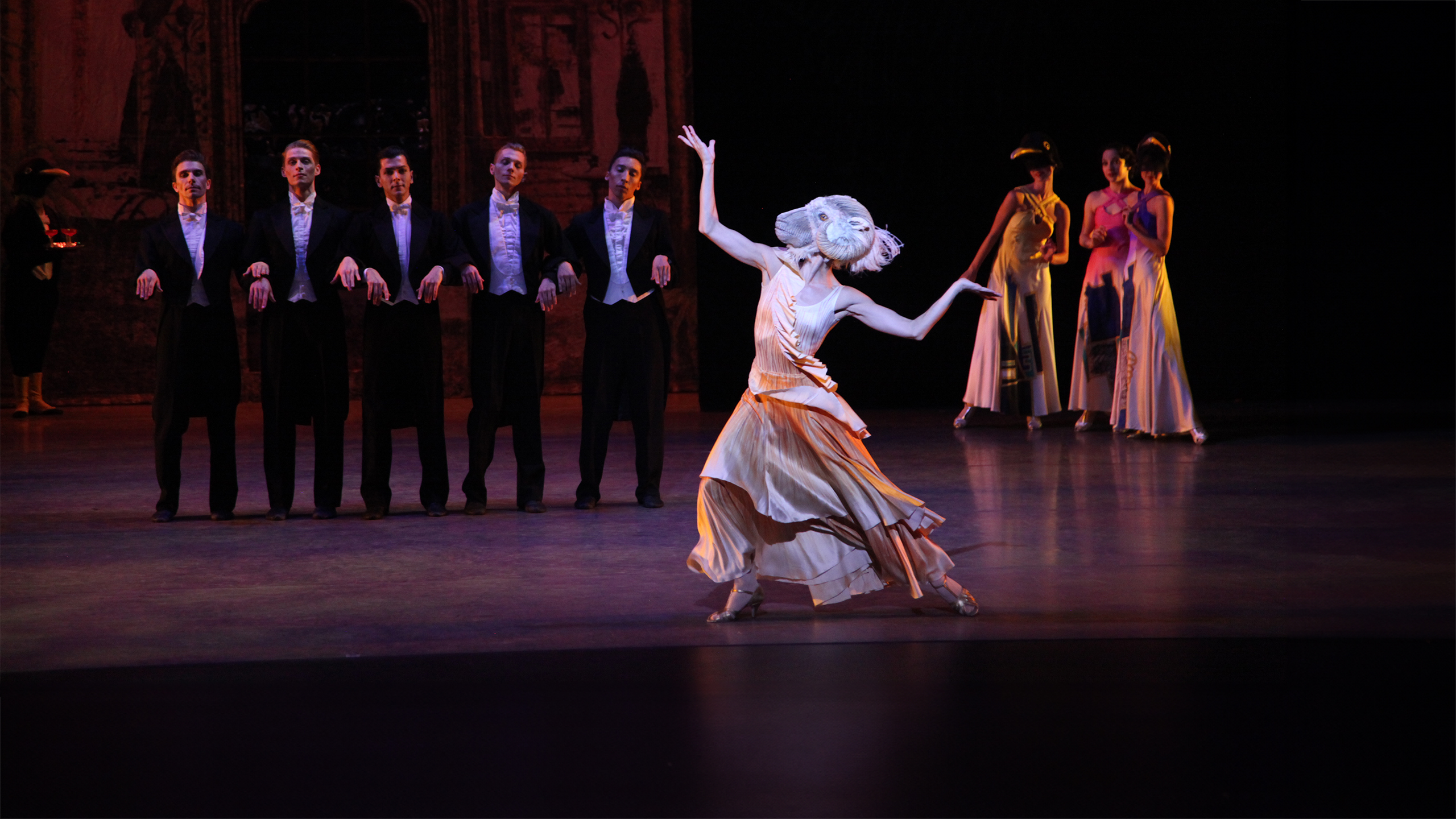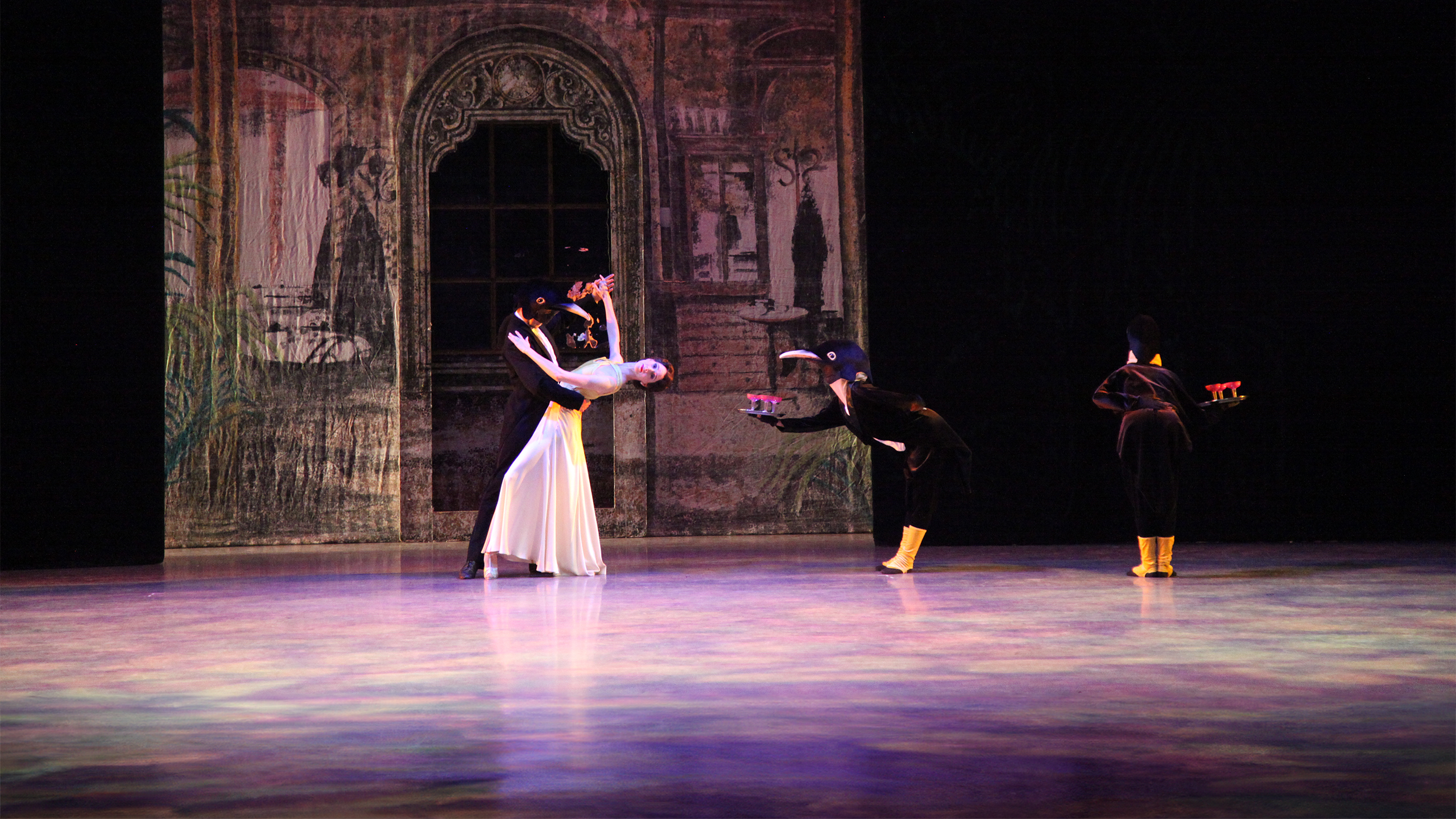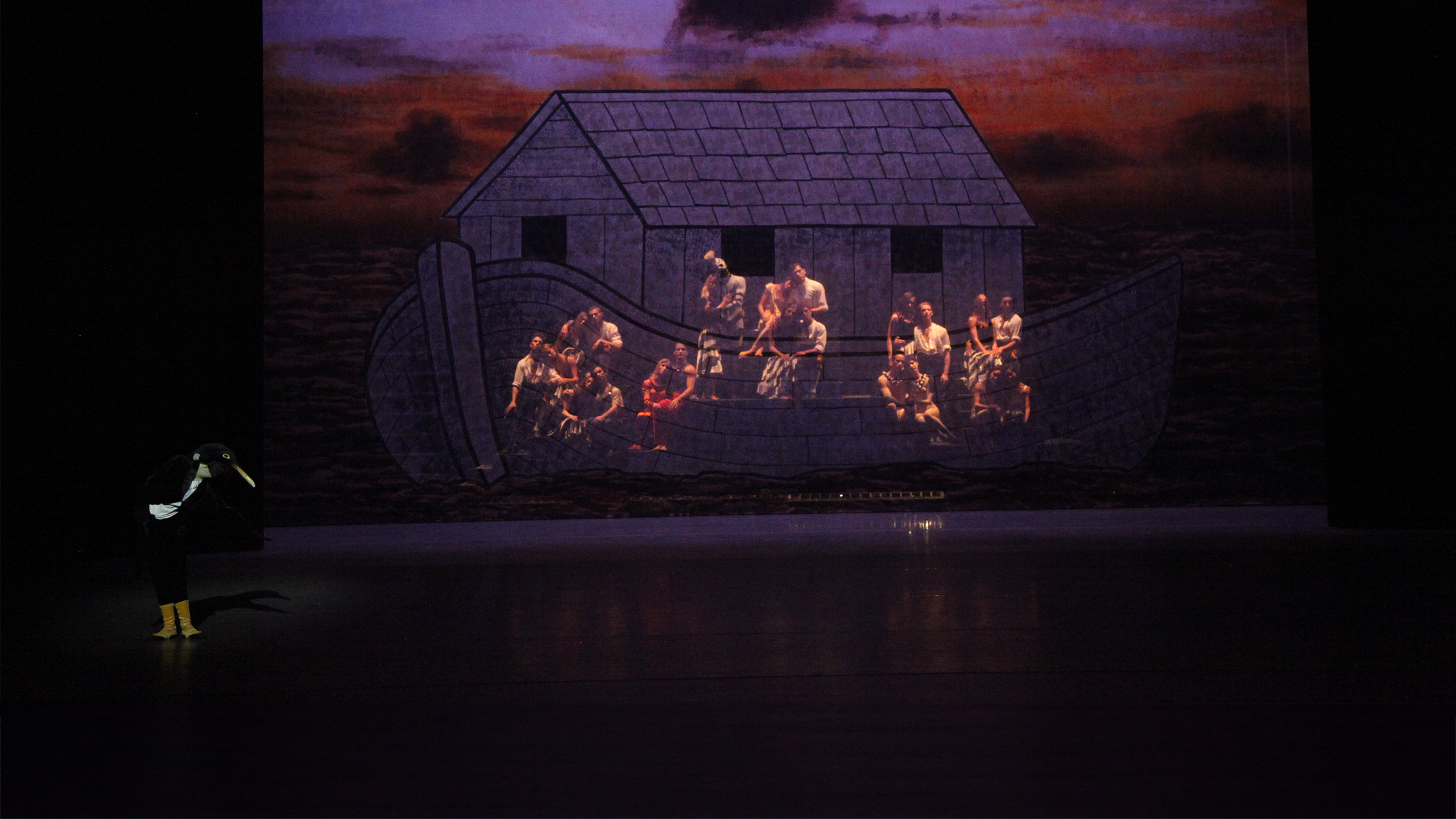Sir David Bintley
Premiered March 9, 1988, by The Royal Ballet
The Sarasota Ballet Performing Sir David Bintley’s ‘Still Life’ at the Penguin Café | Photo by Frank Atura
The Sarasota Ballet Performing Sir David Bintley’s ‘Still Life’ at the Penguin Café | Photo by Frank Atura
The Sarasota Ballet Performing Sir David Bintley’s ‘Still Life’ at the Penguin Café | Photo by Frank Atura
‘Still Life’ at the Penguin Café
“Way ahead of its time,” says original cast member Deborah Bull, “it works on so many different levels. You could call it cabaret with a dark underbelly.” In 1988, when David Bintley decided to present a serious issue in a whimsically light-hearted manner, concern for the environment and the gradual extinction of many species was perhaps less widely expressed than it is today.
Working on developing the characterizations of his endangered creatures in close collaboration with designer Hayden Griffin, composer Simon Jeffes (in the selection of different tracks from the various Penguin Café Orchestra albums) and his original cast, David Bintley drew his audience’s attention to the deliberate pun of “still life,” referencing both the classical painting genre and the hope of “yet living.”
Bintley’s original program note relates the brutal extinction of the Great Auk, the Atlantic’s original penguin, when, on June 3, 1844, on the island of Eldey off the coast of Iceland, three fishermen clubbed to death the last surviving mating couple and crushed their single egg. That’s the point of the ballet, a cautionary tale about our environment at risk and our criminal indifference to its survival, yet served up with wit and imagination, without preachiness, as an entertainment by the doomed species themselves.
In a stylish café restaurant, a series of creatures threatened with extinction take the floor as cabaret turns, from the Texas Kangaroo Rat and Humboldt’s Hog-nosed Skunk Flea, to the Brazilian Woolly Monkey and a Ginger Rogers-ish Utah Longhorn Ram, each creature characterized with wit and style, in both dance and costume terms. Typical of the entire approach is the ‘White Mischief’ section, in which a heartlessly self-regarding cadre of ladies, elegantly dressed in black and white stripes, witness unmoved the onstage slaughter of the noble Southern Cape Zebra, a role famously created in 1988 by the dancer Philip Broomhead.
Like much of David Bintley’s work, Still Life has an unmistakable Englishness, and sits consciously and proudly within The Royal Ballet’s de Valois and Ashton tradition, drawing on ballroom, show, and folk dance, here specifically English Morris dancing. The ballet has been wildly popular and much revived since its triumphant 1988 premiere.
It was at the age of four that Sir David Bintley was bitten by the performing-arts bug at a Sunday-school concert in his native Yorkshire village of Honley. He has gone on to be one of the major players in British ballet: first as a marvelously musical and entertaining character dancer with what was then the Sadler’s Wells Royal Ballet; next, for 24 years as artistic director of the company it became, Birmingham Royal Ballet; and now, choreographing diversely themed ballets for companies all around the globe. Throughout this time, Bintley has become one of the most distinguished neoclassical choreographers of the modern age.
Born in 1957, he trained throughout his teens and at 16 won a place at The Royal Ballet Upper School. A contract at SWRB followed in 1976, and before long he was delivering gold-standard interpretations of such characters as Ashton’s Ugly Sister in Cinderella, Alain and Widow Simone in La Fille mal gardée, Bottom in The Dream, and the lead in Petrushka.
It was in 1978, thanks to SWRB’s sharp-eyed director, Sir Peter Wright, that Bintley received his first commission with the company and created The Outsider, a work very much in the dramatic tradition of Ashton, de Valois, and MacMillan. In 1983, he became SWRB’s resident choreographer and from 1986 to 1993 held the same post with The Royal Ballet in Covent Garden. In 1995 he took over from Wright at the Birmingham Royal Ballet, while from 2010 to 2014 he was also artistic director of the National Ballet of Japan.
Bintley’s works are as plentiful as they are varied, including Allegri diversi (1987), ‘Still Life’ at the Penguin Café (1988), Hobson’s Choice (1989), Tombeaux (1993), Edward II (1995), Carmina Burana (1995), Far from the Madding Crowd (1996), The Seasons (2001), Beauty and the Beast (2003), Cyrano (2007), Sylvia (2009), and Cinderella (2010).
Bintley’s 24 years with the Birmingham Royal Ballet were not only a matter of creating new works and commissioning new scores – he also brought to the repertoire many of the great classics that embody The Royal Ballet. In March 2018 he announced his plan to retire from BRB by the end of July 2019, whereupon he was succeeded by acclaimed dancer Carlos Acosta. In the 2020 New Year Honours appointments, he was awarded a Knighthood for his services to dance. Now focused on purely creative pursuits, Bintley continues to sculpt the ballet landscape with his unique vision, serving as a true successor to the distinguished lineage of British classical ballet.
Born in 1949 in Crawley, Sussex, the son of a research chemist, Jeffes spent his childhood years in Canada before returning to school in England and studying classical guitar at London’s Royal Academy of Music. Already dabbling in experimental music and playing with avant-garde ensembles like the Omega Players, Jeffes found new musical inspiration in Japanese and African music and, during an illness in France, conceived the idea of a wildly eclectic music ensemble, The Penguin Café Orchestra, whose first album was released in 1976 on Brian Eno’s record label. “I am the proprietor of the Penguin Café,” Jeffes wrote of a visionary experience: “I will tell you things at random.”
During the 1970s, Jeffes was also working as an arranger and musical advisor, notably through Malcolm McLaren for Sid Vicious, The Sex Pistols and Adam Ant, moving between Punk and New Romantic. Ahead of his time, he was experimenting in minimalism, African and other ‘World Music,’ and earning good money with catchy soundtracks for major TV advertising campaigns.
“At the helm of the Penguin Café Orchestra,” his obituary remarked, “he transcended musical genres and broadened the listening perspectives of many people.” With such albums as Music for a Found Harmonium and Sign of Life, the Orchestra developed a cult following without hitting the mainstream until the 1988 triumph of ‘Still Life’ at the Penguin Café, on which he worked closely with Sir David Bintley. Simon Jeffes died in 1997 at 48 of an inoperable brain tumor, and the Penguin Café Orchestra disbanded.
Born in Pietermaritzburg, South Africa, in 1943, the stage designer Hayden Griffin grew up in comfortable circumstances, studied at Durban School of Art, and moved to Britain in 1965 to pursue his career and escape the Apartheid regime, which kept him under surveillance because of his links with the African National Congress, and withdrew his citizenship until he became a naturalized UK citizen in 1973. He served an apprenticeship with the illustrious London theatre design firm Motley, and got his first design job at Coventry in 1968.
Success in theatre designs for plays by Edward Bond, David Hare and other leading writers led him from William Gaskill’s Royal Court to the National Theatre and the West End, designing David Hare’s Plenty and (with Howard Brenton) Pravda, David Mamet’s Glengarry Glen Ross, Harley Granville Barker’s The Madras House, and Sophocles’ Oedipus at Colonus. In all, he designed over 30 world premiere play productions as well as for the Metropolitan Opera and a series of David Bintley ballets including Hobson’s Choice, Far From the Madding Crowd and Cyrano. He died in 2013 at the age of 70.
John B. Read works prolifically in dance, opera, theatre and music, both in the UK and abroad. From 1992 to 2005 he was consultant lighting designer to The Royal Opera, The Royal Ballet and BRB. Choreographers he has worked with include Ashton, MacMillan, Tudor, Tetley, Robbins, Nureyev, Dowell, Bintley, Makarova, Hynd, Eagling, Marriott, Dove, Page and Cohan. He has worked with the companies of La Scala, Milan, Stuttgart, Deutsche Oper, Komische Oper, Dresden, Mainz, Vienna, Lyon, Toulouse, Copenhagen, Stockholm, Helsinki, Lisbon, Netherlands, Prague and Canada, as well as for NYCB, Houston, San Francisco, Pittsburgh, Cincinnati, the Alvin Ailey Companies, Rambert, London City Ballet and ENB. Othe credits include Rite of Spring (La Scala, Prague National Ballet), La Bayadère (DNOB), Song of the Earth (Munich, Scottish), Manon (Hungarian State Opera, Stanislavsky Theatre, Sächsische Staatsoper) and Marguerite and Armand (Royal Ballet, Bucharest, Mariinski and La Scala).


